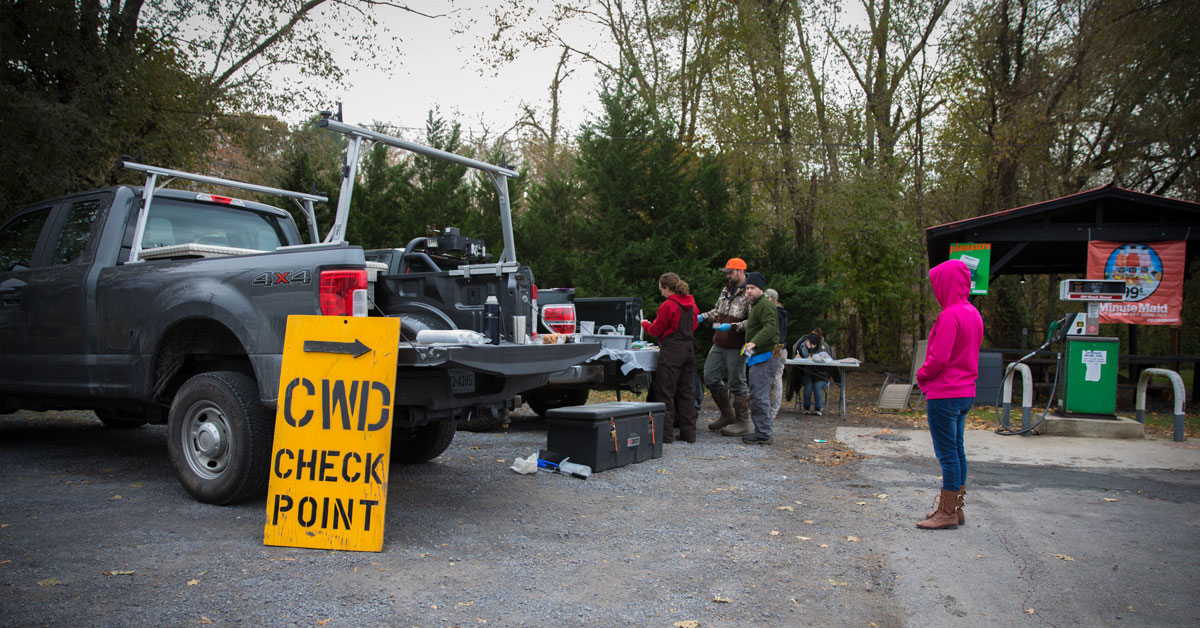
Photos by Meghan Marchetti
Hunting season is almost upon us and the anticipation is building. What better way to start the season than to see a beautiful, healthy deer cross in front of your tree stand? Any Virginia hunter will tell you there are a lot of healthy ones out there!
Unfortunately, a disease introduced to the eastern US within the last 20 years represents a new challenge to Virginia’s deer herd. Chronic Wasting Disease (CWD) is considered a significant threat to the long-term health and stability of the Virginia deer population.
What is Chronic Wasting Disease?
CWD is a central nervous system disease that affects deer, moose, and elk. It is an infectious disease that is 100% fatal to affected animals, with no known treatment or vaccine. The best ways to prevent the disease from spreading is to minimize or eliminate the movement of live captive deer and elk, restrict the importation of whole deer carcasses, avoid the use of lures and attractants that contain deer urine or scent gland secretions, and prevent the congregation of animals at feeding or mineral lick sites. CWD is a serious disease that has the potential to cause significant negative long-term population impacts.
What Causes CWD?
CWD is caused by an abnormal protein called a prion, which is different from a bacteria, virus, or parasite. These abnormal proteins accumulate in the brain of infected animals and cause small holes to form, eventually leading to death. Prions can survive for years in the environment.
How is CWD Spread?
The primary risk for spreading the disease has been, and continues to be, the movement of live deer within and across state boundaries. CWD is spread from sick to healthy deer in a variety of ways, including saliva, nasal discharge, urine, and feces. Prions may be transferred through direct (nose-to-nose) contact or by indirect means via soil, feed, or any surface contaminated with prions.
Where Has CWD been Found?
As of September 2018, CWD has been diagnosed in cervids in 25 states, four Canadian Provinces, and two European countries. In Virginia, CWD has been detected in Frederick and Shenandoah Counties. It has also been found in nearby Maryland, West Virginia, and Pennsylvania.
What Does an Infected Deer Look Like?
Deer do not typically display clinical signs when first infected, but once the disease has been present in their system for 12 to 24 months, the deer will become thin, lose their fear of humans, exhibit a wide-base stance, drool excessively, and/or exhibit a drooping head and ears.
 What is DGIF Doing About CWD?
What is DGIF Doing About CWD?
DGIF has taken a proactive approach to attempt to contain CWD in the northwest portion of the Commonwealth. DGIF prohibited the importation of whole deer and elk carcasses and high-risk carcass parts from all states and provinces where CWD has been detected and prohibited the use of natural deer urine lures. DGIF also enhanced the regulation of captive deer and elk at zoos and research facilities. DGIF delineated a CWD Containment Area (CA) after the initial detection of CWD in 2009 in Frederick County. The current CA encompasses Clarke, Frederick, Shenandoah, and Warren counties. Within the CA, DGIF prohibited feeding deer year-round to minimize interactions between sick and healthy deer and also liberalized hunting to decrease deer densities.
What Can You Do to Help Fight CWD?
- Don’t feed the deer. Concentrating deer around a feed pile or mineral lick increases the chances of contact between sick deer and healthy deer.
- Know before you go! If you are hunting out of state, check the DGIF website to see what deer parts you can legally bring back to Virginia.
- Don’t discard leftover parts of harvested deer on the landscape! Infected deer carcasses can contaminate the local environment and expose healthy deer to CWD. Deer carcasses should be buried or double-bagged and placed in a bin with household trash for home pick-up or discarded at a landfill or compactor site.
- Do not use lures or attractants that contain natural deer urine or scent gland secretions. The use of these products is illegal because they may contain the infectious agent that causes CWD.
- Contact the Wildlife Conflict Helpline at 1-855-571-9003 if you see a thin deer that is also is not scared of humans or pets, stands with a wide stance, is drooling excessively, or is exhibiting a droopy head or ears.
- Please see dgif.virginia.gov/wildlife/diseases/cwd for additional information on CWD.
Help Keep CWD Local!
- Don’t transport whole deer carcasses out of the CA. Only certain parts (boned-out or quartered meat, antlers, hides or capes with no heads, etc.) can be transported out of the CA.
- If you hunt in the CA on November 17th or 24th, bring your deer to a CWD station for mandatory sample collection.
- If you hunt in the CA at any point during the season and want to get your deer tested for CWD, bring the head and 4 inches of neck to a DGIF refrigerated drop point.
- An abundance of deer on the landscape makes it easier for the disease to spread, so keep hunting!
- Please see dgif.virginia.gov/wildlife/diseases/cwd for locations of CWD stations and DGIF refrigerated drop points.
DGIF considers CWD a very serious disease threat to the Virginia deer population but we can’t stop the spread of this disease alone. We are depending on the help and cooperation of all of Virginia’s hunters and wildlife enthusiasts to make decisions today that will benefit the deer populations and hunters of the future. Please follow CWD rules and regulations and help to spread awareness about CWD. Most importantly, be safe this fall, enjoy your time in the woods, and good luck getting that big buck or doe to cross your path!

